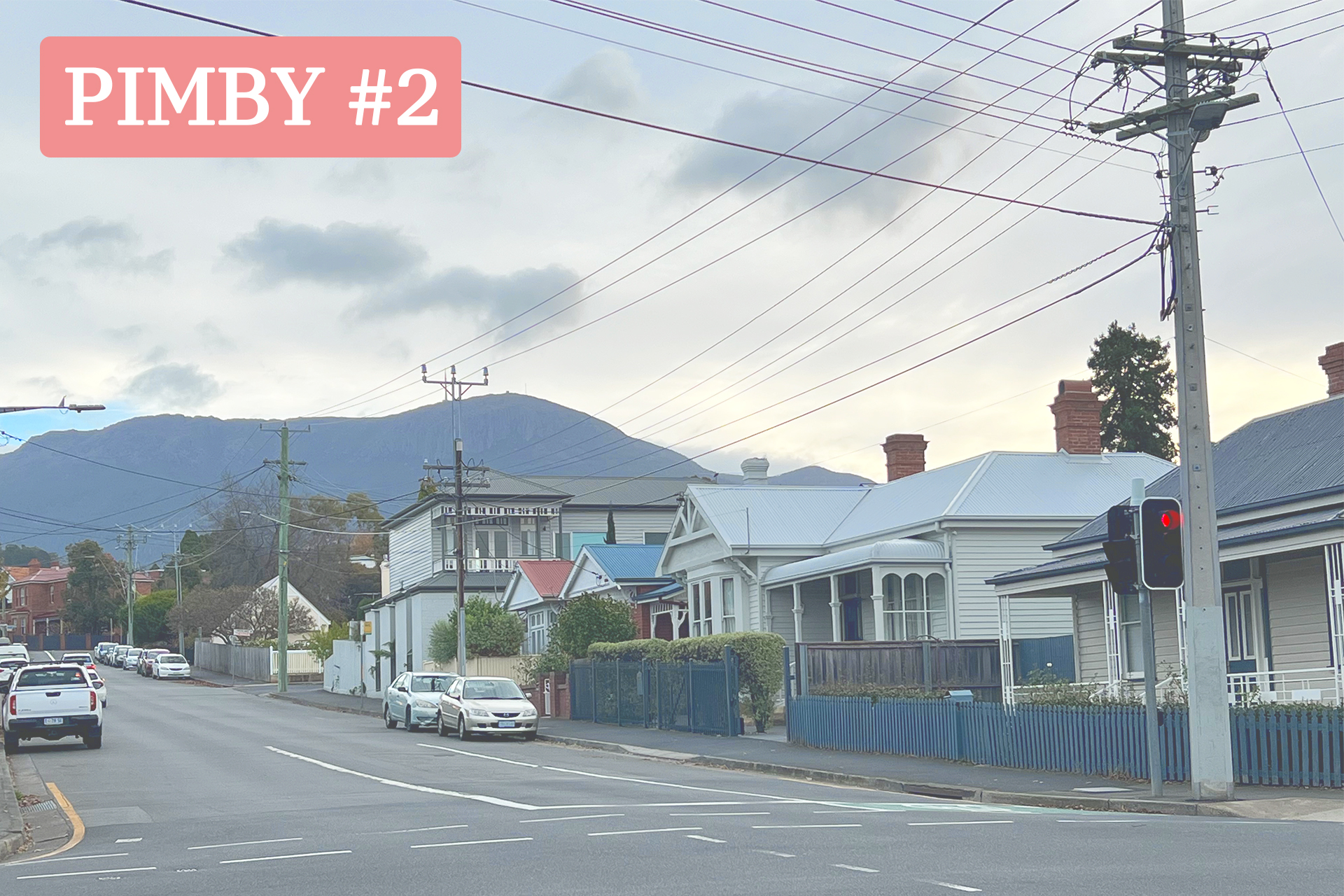With a federal election just around the corner and cost of living still
the
most important issue for voters, this week’s PIMBY takes a closer look at the situation in Tasmania.
How Australia is doing
Let’s start with the big picture. The main measure we’ll discuss is household disposable income adjusted for inflation. This is the ‘real’ value of the money people have available to spend or save after paying tax. Compared to other developed countries, Australia hasn’t been doing well. The most recent available data show Australian disposable incomes declined a lot faster than in any other OECD country in 2023:
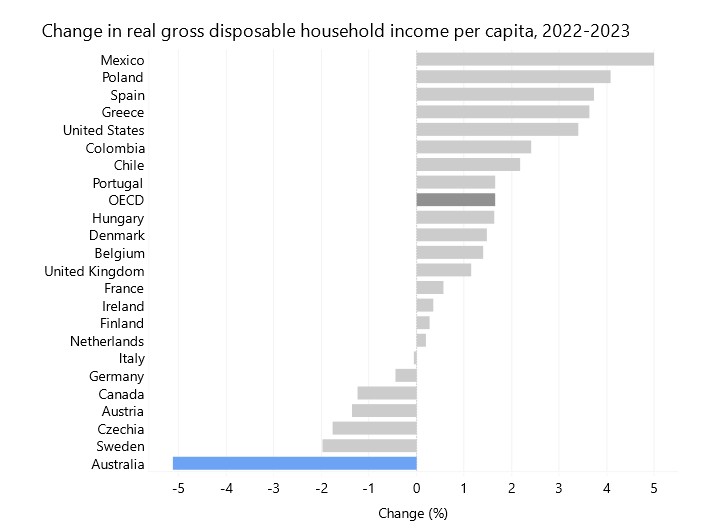
This is mainly because we’ve had a combination of
high inflation and slow wage growth. There are other factors in play though, including that Australian households have
relatively high debts with variable interest rates and ‘
bracket creep’ [paywalled] resulting in higher average income tax rates.
What about Tassie?
The average Australian household has been struggling, and Tasmania is no exception. Tasmanian households’ disposable income reached a ten-year high in 2021, but by mid-2023 they had fallen by more than 7%:
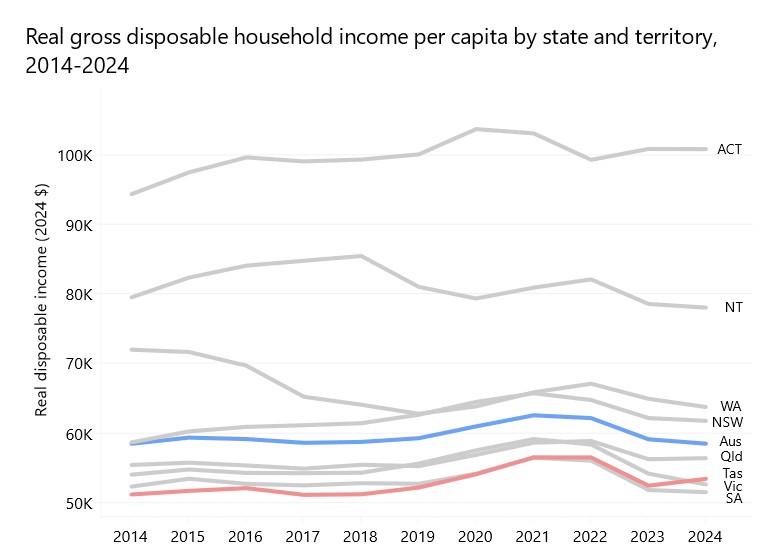
As in other states, this decline was driven by the usual suspects: the highest inflation
since 1990 combined with sluggish wage growth. Low
productivity growth has also been a major contributor.
Light at the end of the tunnel?
The good news is that after a few very hard years, there maybe cause for cautious optimism. The chart above shows that over the 12 months to July 2024, Tasmanian household disposable income rose by almost 2%. Over the same period, Queensland saw an increase of just 0.25%, while everyone else went backwards. As a result, Tasmania’s disposable household income per capita is now higher than both Victoria’s and South Australia’s.
There are two things behind Tasmania’s recent gains. First, in the twelve months to December 2024,
CPI inflation in Hobart was just 1.54%. This was the lowest in the country, well below the national average of 2.42%. One of the major reasons we had such low inflation was a fall in the cost of renting. Not so long ago, Tasmania had the unenviable title of
Australia’s most unaffordable city for renters. But since 2020/21, the Australian median ‘real’ (i.e., adjusted for inflation) rent has increased by about $150 a week while Tasmanian rents have flatlined over the last two years:
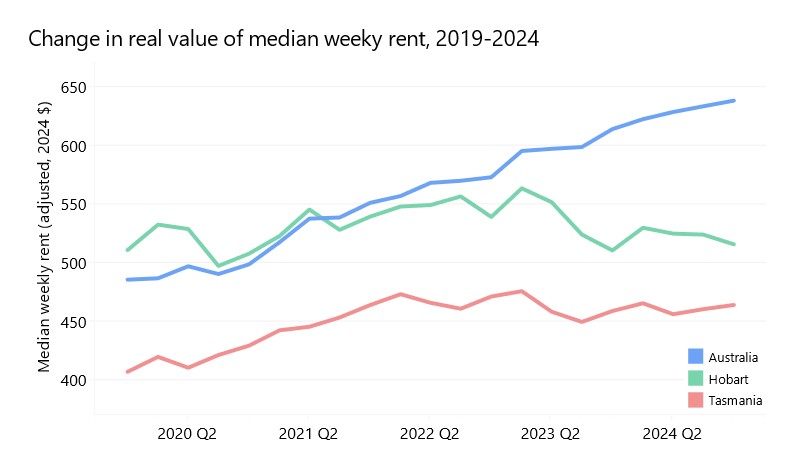
The second factor is Tasmania’s recent strong real income growth. During the same 12-month period in which Tasmania recorded Australia’s lowest rate of inflation, we also saw nation-leading wage growth of 3.9%:
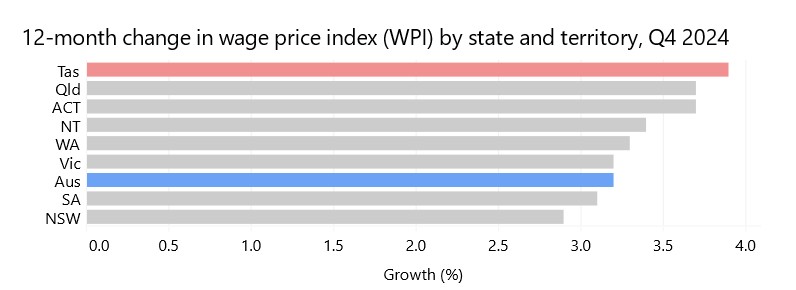
With inflation running at an average of 1.54% over that time, this means ‘real’ wages grew by almost 2.4%, which is more than three times the national average rate. A significant factor in this wage increase was a
4.7% rise in public sector wages – which is the sector in which
roughly 22% of Tasmanians work. In contrast, private sector wages rose 3.6%, which is much closer to the national average.
The stats versus real life
Growing wages and slower inflation are good news, but many Tasmanians are still doing it tough. What’s going on here? There are probably a few factors at play:
- Disposable income data is based on averages. This means that things might not be so rosy for specific groups of people. What these data don’t reveal is whether the increase in disposable income is evenly spread across all income brackets and areas of the state… Perhaps it’s concentrated in Hobart and Launceston, or driven by only the high income earners.
- Inflation affects different types of households in different ways. We know that inflation impacts
lower-income households differently to higher-income ones. For example, Reserve Bank research points out that wealthier households have financial buffers to manage temporary budget squeezes. Households with large mortgages have likewise been much more heavily impacted by rapidly rising interest rates than people who own homes outright. The same applies to regional differences: we know that inflation affects households in rural or regional areas differently to urban ones, but it’s very hard to know by how much. - Changes take a while to be felt. The positive trends above only emerged in 2024 and probably haven’t had time to filter through to people yet. Take rent as an example: falling advertised rents are great if you’re looking for new digs, but they won’t make any difference if you’re already on a lease. It’s the same for income: people changing jobs might be offered a better wage, but that doesn’t mean most people will get a raise in their current jobs (or at least not straightaway). These things take time to wash through the economy.
In summary, the fact that people with lower incomes and those in regional areas are still experiencing a lot of cost-of-living pressure suggests the improvements we noted above haven't been shared equally across Tassie households.
Getting out the crystal ball
So, the data for the past year looks positive, but the real-world impacts haven’t filtered through yet. And unfortunately, the economic tea leaves for 2025 and beyond indicate that any positivity could be short-lived.
Frankly, the economic outlook is not great. The latest
Deloitte Business Outlook report [paywalled] predicts that the Tasmanian economy will shrink by 1.1% in 2024/25. Rents have mainly been falling because population growth has stalled, not because we’re building more houses. And household spending is expected to fall by 0.5% in 2025. The signs aren’t great for continued wage growth either, because unemployment is increasing.
What do we do about it?
Given
Tasmania’s current fiscal situation, this is a tough question to answer. But fortunately, there are plenty of ideas out there. Saul Eslake’s
Independent Review of Tasmania’s State Finances puts forward suggestions for repairing the state budget while supporting economic growth including aligning our mineral royalties to match other states and territories, gradually replacing stamp duty with a broad-based land tax, and lowering the payroll tax-free threshold.
As a community and economy we have many strengths, and attracting
investment in the transition to a zero-emissions future could really pay off. We live in a knowledge economy and, above all, improving Tasmania’s labour productivity –
the worst in the nation – by investing in people and ensuring that more Tasmanians have the education and skills to thrive in the 21
st century will also be vital. These are ideas that we’ll return to in future editions of PIMBY.
